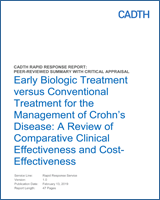| Kang 2016, South Korea27 | Prospective observational study comparing two groups of patients who received infliximab: either as part of step-up or top-down Patients prospectively enrolled and could choose to receive step-up or top-down with their guardian after explanation of options Study was specifically interested in those who received infliximab (either early or as part of step-up) and therefore only included in step-up group if eventually received infliximab after failure of conventional therapy | n=76, median age at diagnosis 14 years for step-up and 15 year for top-down, 64% male, median PCDAI = 35, median duration to infliximab treatment 8 months in step-up and 0.7 months in top-down Pediatric patients (< 18 years of age) with moderate to severe luminal disease were included (excluded if mild disease, penetrating disease, strictures, refractory perianal strictures or history of bowel surgery) | Top-down: within 1 month from diagnosis, infliximab 5mg/kg at 0, 2, 6, 14 weeks then every 8 weeks plus AZA 0.5 to 1 mg/kg/day (adjusted as required) plus mesalazine 50 mg/kg/day Step-up: oral corticosteroid (not specified) 1 mg/kg/day tapered over 8 weeks plus AZA 0.5 to 1 mg/kg/day (adjusted as required) plus mesalazine 50 mg/kg/day; if disease relapsed then infliximab initiated (as in top-down group) | Primary outcome: mucosal healing (SES-CD score=0) at 14 and 54 weeks from baseline infliximab Secondary outcomes: clinical remission (PCDAI<10), PCDAI, adverse events, SES-CD score Baseline was first infliximab dose |
| Lee 2015, South Korea30 | Retrospective review of a prospective study Conducted at one hospital based on patients from 2008 to 2012; 2 groups depending on treatment received (therapy decisions made by guardians after explanation of treatment options) | n = 51, median age at diagnosis 15 years old, sex not described Patients had moderate to severe Crohn’s (PCDAI 39 in top-down and 34 in step-up at baseline) Disease duration 1 month in top-down versus 10.8 months in step-up 71% had fistula in top-down and 55% in step-up Patients in step-up initially achieved remission on conventional but eventually required infliximab | Top-down: patients who started infliximab at the time of diagnosis (in combination with AZA, mesalazine and corticosteroids) Step-up: patients who started infliximab after relapse (and where remission had been achieved with conventional therapy) Infliximab given 5 mg/kg week 0, 2, 6 then every 8 weeks | Disease remission (PCDAI < 10 points) Relapse free rate (relapse defined as PCDAI > 10 points after clinical remission), adverse events Follow-up over 3 years |
| Walters 2014, USA and Canada29 | Prospective observational study (data from 28 pediatric gastroenterology centres in North America from 2008 to 2012); propensity score matching to create three groups: (1) early anti-TNF, (2) early immunomodulator, (3) no early immunotherapy | n=552 (propensity score matched sample n=204); median age 13.8 years for anti-TNF, 12.6 years for immunomodulator, 12.0 years for no therapy; 62% male; 45% with moderate to severe Crohn’s disease Patients <17 years of age newly diagnosed with non-penetrating, non-stricturing disease were included; patients receiving early anti-TNFα in combination with an early immunomodulator were excluded | Three groups:
- (1)
early anti-TNF - (2)
early immunomodulator - (3)
no early immunotherapy
Early = within 3 months of diagnosis; all patients could receive corticosteroids or mesalamine | Primary outcome: corticosteroid free clinical remission (PCDAI < 10) at 1 year after diagnosis |
| Lee 2012, South Korea25 | Retrospective chart review Charts were reviewed at one hospital in patients followed for at least 36 months between 1998 and 2009; patients were put into 2 groups depending on treatment received | n = 28, 14% female Mean age 13 years Mean PCDAI score at diagnosis 40.5 Patients either had moderate or severe CD (top-down group) or had therapy-resistant CD (step-up group) | Top-down: infliximab 5 mg/kg at 0, 2, 6 weeks then every 8 weeks for 10 months in combination with AZA daily Step-up: oral prednisolone 1 to 2 mg/kg/day and mesalamine (50 to 80 mg/kg/day) or AZA (2 go 3 mg/kg/day), then infliximab | Relapse (PCDAI > 10 points after remission) Evaluated at 1, 2, and 3 years |
| Kim 2011, South Korea28 | Researchers identified patients given infliximab for therapy resistant or severe Crohn’s disease between 2001 and 2008; these patients were identified from two hospitals and had to have follow-up data for 1 year; patients grouped according to therapy received | n = 29, 17% female Mean age 14 Patients had therapy resistant (step-up group) or severe Crohn’s (top-down), mean PCDAI score 41; 62% of patients had a fistula | Top-down: infliximab 5 mg/kg at 0, 2, 6 weeks then every 8 weeks for 10 months in combination with AZA daily Step-up: oral prednisolone 1 to 2 mg/kg/day and mesalamine (50 to 80 mg/kg/day) or AZA (2 go 3 mg/kg/day), then infliximab | Disease remission (PCDAI score < 10), adverse events, clinical status (PCDAI score), fistula closure, adverse events, at 8 weeks and 1 year |
| Lee 2010, South Korea26 | Retrospective chart review Charts were reviewed at one hospital for newly diagnosed patients naïve to treatment and followed for at least 24 months from 2001 to 2007; patients were divided by 3 groups depending on which treatment they received | n = 36, 25% female Age 1 to 16 (median 13) Newly diagnosed with Crohn’s disease (mean PCDAI at diagnosis 33) | A: oral prednisolone (1 to 2 mg/kg/day) then mesalamine (50 to 80 mg/kg/day) B: oral prednisolone then AZA (2 to 3 mg/kg/day) C: infliximab 5 mg/kg at 0, 2, 6 weeks then every 8 week for 10 months, plus AZA | Relapse (PCDAI > 10 after remission) Adverse events Follow up at 12 and 24 months |
